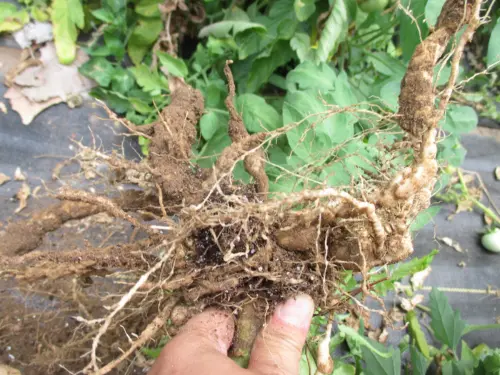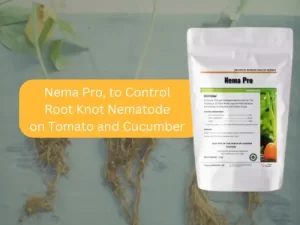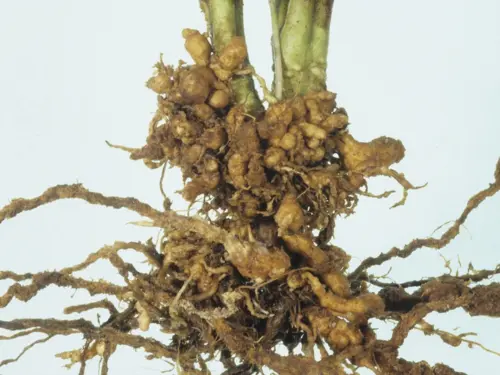Microscopic root knot nematode, which cause great economic losses for crops such as tomato and cucumber, are notorious. These pests enter the root systems of the plants and form galls which, in effect, disturb the water and nutrient intake thereby leading to stunted growth, reduced yields and even results in plant death in some critical cases.
The existence of root knot nematodes in soil is one of the most considerable hazards to cucumber and tomato cultivation, the two biggest vegetable crops in the global economy. Infestations will bring on major economic losses since the good quality and yield reduction has become obvious which reminds pest control and management.
Given the challenges posed by root knot nematodes, adopting integrated management strategies becomes crucial. These strategies highlight the strategy of biological measures in nematode management as a basis of sustainable approach to nematodes. Integrated pest management is one of the management approaches that focus on avoiding a total reliance on chemical pesticides. This, in turn, reduces their environmental impact and promotes the health of the ecosystem and of all its inhabitants. Through biological approaches and by adding on cultural and when needed chemical controls root knot nematodes can be properly controlled so as to promote sustainable practice and high yield tomato and cucumber crops.

The battle against plant-parasitic nematodes takes a promising turn with biocontrol agents like Purpureocillium lilacinum. This eco-friendly nematicide effectively controls various nematode species. Purpureocillium lilacinum surrounds nematode eggs with biocontrol bacteria hyphae and penetrates them with metabolites and chitinase, effectively killing nematodes. This inhibits egg hatching and limits nematode growth, achieving high egg parasitism rates.
Paecilomyces lilacinus is a fungus celebrated for its ability to combat root knot nematodes, a pervasive threat to tomato and cucumber cultivation. These parasitoids are a fungus species that control nematodes only at the egg stage and therefore disrupt their way of life, greatly reducing nematode populations in agricultural soils.
The interaction between the fungi and nematode eggs is carried out through the fungi prowling into the eggs, eating the contents of the eggs, thereby, checking the arrival of new nematodes. This goal-oriented approach helps to prevent the side effect on indiscriminate organisms (non-targeted species). Such a consequence is ecologically sustainable, which is still one of the key factors in sustainable agriculture.
Research has proved ligatum lilacinus into an effective control method, and results of the trials show that nematode egg contents could be reduced by up to 70%. It means there will be a decrease of the order as high as 60%. Therefore, there will be a low incidence of root-knot nematode attacks on both tomato and cucumber crops, and hence safeguard their health and productivity.
Managing root-knot nematodes in tomato and cucumber demands complex, multi-layered technologies integrating chemical and organic techniques. Effective strategies must be used moderately for sustainable nematode control.

This strategy promotes combining chemical and organic methods to control root-knot nematodes in tomato and cucumber crops. Nematicides function rapidly and effectively but pose environmental consequences, requiring careful use. Organic amendments offer a more sustainable approach, albeit slower-acting, in nematode control. They aid in restoring soil health, creating a hostile environment for nematodes, ensuring long-term pest control.
Novobac introduces Nema Pro, a nematicide derived from Purpureocillium lilacinum, offering high efficacy and environmental sustainability. It ensures safety for beneficial organisms.

Nema Pro is an organic nematicide designed to combat plant parasitic nematodes, including the pervasive root-knot nematode. Made from the naturally occurring fungus Purpureocillium lilacinum, it exhibits true nematicidal activity against eggs, juveniles, and adult root-knot nematodes. This product effectively tackles root-knot nematode issues while enhancing root growth and plant health, offering superior solutions for gardeners and farmers.
High Efficacy
Nema Pro underwent rigorous field trials, showcasing up to 80% reduction in root-knot nematode populations. This reduction directly lowers crop infestation rates. Consequently, it’s anticipated to yield healthier, higher-performing plants with increased growth and yield potential. Root-knot nematodes significantly hinder crop health and productivity.
Environmental Friendliness
As an organic product, Nema Pro aligns with the growing demand for sustainable agricultural practices. Nema Pro’s formulation, derived from Paecilomyces lilacinus (now Purpureocillium lilacinum), guarantees no harmful residues in soil or crops. This feature suits organic systems where synthetic chemicals are restricted.
Safety for Beneficial Organisms
One of the critical advantages of Nema Pro over chemical nematicides is its safety profile for non-target organisms. Chemical nematicides often have a broad spectrum of activity, which can inadvertently harm beneficial soil fauna that contribute to soil health and fertility. In contrast, Nema Pro targets root-knot nematodes specifically, without adversely affecting beneficial organisms. This selective activity helps preserve the ecological balance within the soil, promoting a healthier growing environment for crops.
For achieving optimal control of root-knot nematodes, Novobac recommends applying Nema Pro at a rate of 3-4.5 kilograms per acre during the planting phase. To maintain control throughout the growing season, a reapplication every 28 days is advised. This regimen ensures continuous protection against nematode infestation.
Incorporating a soil wetting agent into the application process can further enhance the efficacy of Nema Pro. This wetting agent helps the products’ spores to penetrate soil successfully, thereby ensuring they reach the root zone where the root-knot nematodes live. With this approach to application, the product efficacy is maximized and season-long nematode control is provided.
For a long time the agricultural sector has had to use nematicides to control nematode populations; this is very important for the health as well as the productivity of the crops. Nevertheless, Nema Pro is a game-changer enacting the sustainability and environment into the nematode management process.undefined. Here’s a detailed comparison highlighting the advantages of Nema Pro over traditional chemical nematicides:
Traditional chemical nematicides exhibit broad-spectrum activity, harming non-target organisms alongside nematodes, disrupting ecological equilibrium in agricultural systems.
Nema Pro targets nematodes specifically, preserving beneficial organisms crucial for soil health. Its environmentally friendly nature significantly reduces ecological footprint, making it favored by environmentally-minded growers.

The comparative study of Nema Pro with both ordinary nematicide options mentioned the major advantage of moving to the natural, directed and sustainable way of controlling nematodes. Nema Pro stands out from all other pest root knot nematode control products in the market due to its safety for non-target organisms, high efficacy in reducing nematode populations and making it a suitable model for other future pest management products. As the agricultural sector evolves, there will be more focus on products that, besides safety, efficiency, and sustainability, also connect with healthier crops and ecosystems. This shift will most certainly be a major determinant for the future of the industry.
The unveiling of Nema Pro, a revolutionary new product by Novobac, is a game-changer in the ongoing bout between nematodes and plant roots. This new product enhances micro-tunneling technology, improving crop output and environmental footprint while ensuring non-target organism safety.
Its integration into pest management strategies signifies progress towards balanced agricultural systems. Nema Pro serves as a prototype for advanced nematode management, combining biological, cultural, and chemical elements. This holistic approach enhances pest management efficiency, soil health, and ecosystem sustainability. It unites biocontrol agents, cultural methods, and chemical pesticides to combat agricultural pests comprehensively.
Integrating environmentally friendly innovations like Nema Pro is imperative for sustainable pest control and nematode management. Future nematode management will prioritize functional and eco-friendly products, fostering long-term agricultural sustainability. Advances in research and farmer interest in integrated pest management suggest meeting crop and ecosystem needs is feasible.
References:
Cutworms in gardens are a major menace to all..
As a farmer,I inspect my fields daily to monitor..
It all started with a worried farmer named Mr...

Leave a Reply